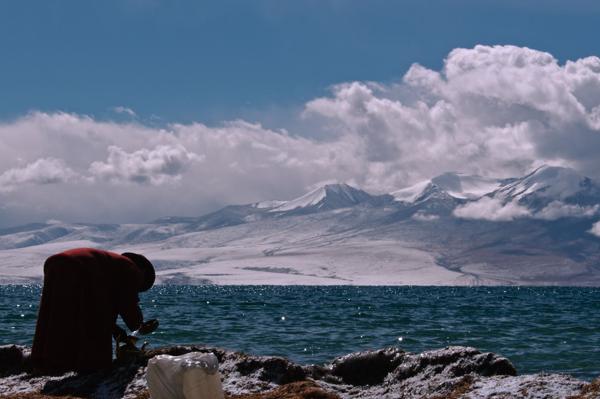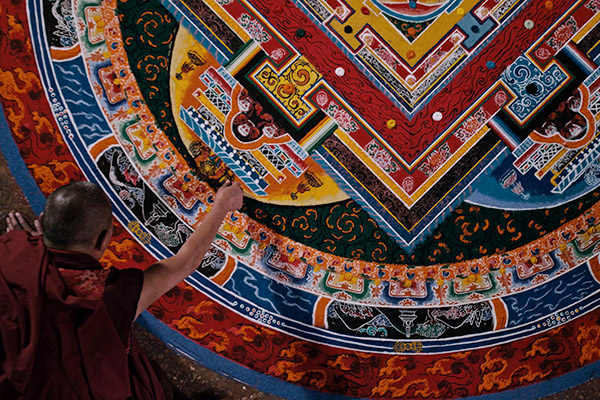
Documentary film Roof of the World shows details about everyday lives and natural landscapes on the Qinghai-Tibet Plateau.[Photo/Provided to China Daily]
A documentary on Tibet has taken China by storm by simply showing the lives of ordinary people in a remote part of the world. Han Bingbin reports.
Documentaries aren’t really popular in China, but a recent film on the Tibet autonomous region has garnered a surprising amount of attention thanks to its unconventional approach to filming the place.
In Roof of the World, a production by China Central Television, grand narratives and political themes are cast aside in favor of showing rich details about the everyday lives and natural landscapes on the Qinghai-Tibet Plateau, which has attracted a younger audience.
On Youku.com, one of China’s largest video streaming sites, the documentary has had more than 25 million views since its debut earlier this month. It is the second most watched locally produced documentary, after the phenomenally popular A Bite of China series. The Tibet documentary has a rating of 9.1 out of 10 on Douban.com, China’s largest film review site.
“We were very worried in the beginning. We certainly know it’s a good production. But nowadays young people are more into fast-food kind of videos, not something that needs you to sit quietly, to feel,” says Wang Yan, director of Youku’s information center.
The success of Roof of the World demonstrates that audiences still have a strong appetite for good documentaries, says Wang Weilai, chief producer of the film. He says that the documentary also led to an unexpected growth of young viewership despite its premiere on CCTV’s Chinese international channel, which traditionally targets middle-aged viewers.

Documentary film Roof of the World shows details about everyday lives and natural landscapes on the Qinghai-Tibet Plateau.[Photo/Provided to China Daily]
On April 10, Roof also started its run on CCTV 9, the country’s most authoritative documentary channel best known for its well-curatored lineup of foreign classics. Some viewers had actually mistaken Roof for a foreign production, says Wang, because of its narrative and filming styles.
“It means, in a way, that they still don’t trust local productions,” says Wang. “But we’ve learned a lesson: A change in the method of storytelling can result in completely different communication effect.”
Roof of the World owes the bulk of its success to detailing daily lives and capturing the people’s natural beauty, says Zhang Yun, director of the Institute of History Studies under China Tibetology Research Center.
“But through these everyday scenes, you can see how Tibet has developed, what has changed and what has not,” Zhang says. “The use of slow motion (in some places), to show things in an unhurried way, helps to bring out some of the essential spirit of Tibetan culture.”
It’s also admirable that these details are presented with “anthropological precision”, says Zhang Yiwu, Peking University professor of Chinese Studies. It approaches the major theme of man and nature by truthfully recording how small lives comply with, and consequently enrich, nature, he adds.
There are also themes, such as animal welfare and rights, which are new concepts to Chinese but were explored in the nature-themed film, Zhang says.

Documentary film Roof of the World shows details about everyday lives and natural landscapes on the Qinghai-Tibet Plateau.[Photo/Provided to China Daily]
An English version of Roof of the World has finished airing on CCTV’s English channel. Global audiences are also expected to see it via the international networks of National Geographic Channel, which recently licensed the documentary. It’s also likely to be available in the future via a number of other mainstream TV stations overseas.
Many Chinese productions haven’t been successful abroad, says Yu Guoming, professor of journalism at Renmin University of China. Chinese productions like to sell concepts in the beginning and later resort to “grand narratives”, he says, whereas Westerner viewers favor the stories and details.
The success of Roof of the World, however, lies largely in tentatively altering its logic of expression, which makes it more adaptable to international tastes, says Yu.
“We’ve made it clear in the beginning that we were not filming something to propagate Tibet or the Qinghai-Tibet Plateau. We want to show, in completion, what people’s lives are like in such a special geographical environment,” says producer Wang.
“We are also determined to follow the common patterns of documentary making in the world, or in our words, to tell China stories in a global expression.”
A 90-minute feature version of the documentary will be aired at the Beijing International Film Festival on April 16.
